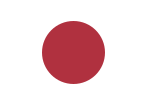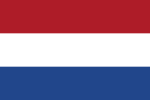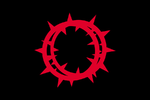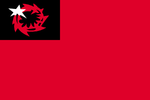List of Japanese flags – Wikipedia
From Wikipedia, the free encyclopedia
This is a list of Japanese flags, past and present. Historically, each daimyō had his own flag. (See sashimono and uma-jirushi.)
National flags[edit]
| Flag | Date | Use | Description |
|---|---|---|---|
 |
13 August 1999 – present | Civil and state flag and ensign of Japan. | Flag ratio: 2:3. This flag was designated by Proclamation No. 127, 1999. The sun-disc is perfectly centered and is a brighter shade of red. |
 |
27 February 1870 – 12 August 1999 | Civil and state flag and ensign of the Empire of Japan, and the Japanese state. | Flag ratio: 7:10. Disc is shifted 1% towards the hoist (left). This flag was designated by Proclamation No. 57, 1870. |
Imperial flags[edit]
Governmental flags[edit]
| Flag | Date | Use | Description |
|---|---|---|---|
 |
1872–1887 | Ensign of Japan Post | Hinomaru with a red horizontal bar placed in the center of the flag. |
 |
1892–present | Ensign of Japan Customs | White represents land, blue represents sea, and the red disc represents the customs on a border. |
Military flags[edit]
Japan Coast Guard[edit]
Historical flags[edit]
| 13th century-19th century | Military Flag of the warriors loyal to Japanese court. | A red field with a golden disc in the center and 3 sestiere on the fly. | |
 |
1429-1879 | Merchant Flag of the Ryukyu Kingdom. | A triangular yellow field with a red border and a red disc in the center. |
 |
1580-1587 | Flag of the Portuguese Empire used in Portuguese Nagasaki. | A white field with a Portuguese coat of arms in the center. |
 |
1602-1871 | Flag of the Satsuma Domain. | A horizontal bicolour of red and white. |
 |
1641-1854 | Flag of the Dutch Dejima | A horizontal tricolor of red, white and blue. |
 |
1863-1867 | Naval ensign of the Tokugawa Shogunate.[1] | A bicolour flag consisting of three bands; white, black, and white. |
 |
1905–1910 | Flag of the Resident General of Korea. | A blue ensign with the Flag of Japan in the canton. |
 |
1945–1952 | Civil and naval ensign during the occupation of Japan. | Derived from International maritime signal flag “E”. |
 |
1797[2]–1879 | Flag of the Ryukyu Kingdom. | Features a mitsudomoe, the symbol of the ruling Second Shō dynasty. |
 |
1950 (Jan–Mar) | Proposed flag of Okinawa. | Called the Okinawan Flag (沖縄旗) or the Ryukyu Flag (琉球旗), proposed by the Okinawa Civil Government. The US administration stated they would decide the flag after the foundation of the unified government of the islands. However, the flag was forgotten ever since. Red, white, and blue represent peace, freedom, and enthusiasm, respectively. A star represents hope. |
 |
1952–1967 | Civil ensign during the occupation of Okinawa. | Derived from International maritime signal flag “D”. |
 |
1967–1972 | Civil ensign of the Government of the Ryukyu Islands. | Ryukyus pennant above Japanese flag was used during U.S. occupation of Ryukyu Islands. |
Daimyō Banners present in old paintings[edit]
Minorities[edit]
| Flag | Date | Use | Description |
|---|---|---|---|
 |
(1996) 1994–[citation needed] | Flag of Mindan | Flag of Mindan, a pro-South organization of Zainichi Koreans. The pink flower surrounding the taegeuk is a hibiscus syriacus, the national flower of South Korea. The formal name of the society (Zainihon Daikanminkoku Mindan) is written in kanji in white, and the abbreviation (Mindan) is written in hangul in yellow. The blue field of the flag stands for clear sky and sea. |
 |
1923–1945[citation needed] | Flag of National Levelers Association / Buraku Liberation League | Flag of National Levelers Association, a burakumin rights group, and Buraku Liberation League, NLA’s succeeding group. Named the Crown of Thorns Flag (荊冠旗, Keikanki). Black represents a dark society with discriminations. Red represents blood. |
 |
1945–[citation needed] | Flag of Buraku Liberation League | The current Buraku Liberation League flag, with a white star representing hope. |
 |
1973–[citation needed] | Flag of Ainu | . |
Cultural flags[edit]
| Flag | Date | Use | Description |
|---|---|---|---|
 |
1919– | Flag of safety | Named the Green Cross (緑十字, Midori-jūji). Designed by Toshifumi Gamō as the symbol of the governmental “safety week” campaign. The cross represents philanthropism in Western sense, and the place where good deeds gather in Oriental sense. JIS Z9103-1986 designates the symbol as the safety indication sign. |
 |
1953– | Flag of industrial health | Announced by the Labour Standards Bureau, the Ministry of Labor of Japan (the current Ministry of Health, Labour and Welfare), over a public subscription. |
 |
1965– | Flag of safety and health | Designed by the Japan Industrial Safety & Health Association. These three flags are frequently flown on factories or construction sites. |
 |
1887– | Postal flag | The Postal symbol, 〒, on a white field. |
Prefectural flags[edit]
Each modern prefecture has a unique flag, most often a bicolour geometric highly stylised design (mon), often incorporating the letters of Japanese writing system and resembling company logos. A distinct feature of these flags is that they use a palette of colours not usually found in flags, including orange, purple, aquamarine and brown.
Some prefectures also have alternative official flags called “symbol flags” (シンボル旗). They may be used on less formal occasions. Famous symbol flags include the one used in Tokyo.
Municipal flags[edit]
Most municipalities have unique flags. Like prefectural flags, most of them are with a bicolour geometric highly stylized symbol, often incorporating Japanese characters.
Political flags[edit]
References[edit]
- ^
- ^ Itai Hidenobu 板井英伸 (2008). ““Naha-kō zu byōbu” ni miru 19 seiki Naha-kō no fune 『那覇港図屏風』にみる19世紀那覇港の船 (19th Century Boats in Naha Port as Depicted in the Naha Port Folding Screen)”. Hikaku minzoku kenkyū 比較民俗研究 (in Japanese). 22 (22): 93–136. Retrieved June 17, 2018.
Recent Comments